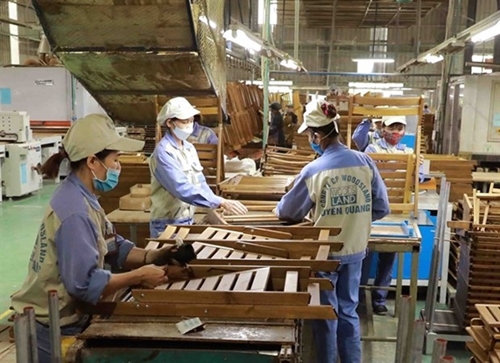    |
 |
|
A preliminary survey by the Handicraft and Wood Industry Association of Ho Chi Minh City (HAWA) finds that export orders of enterprises in the industry decrease by 30% at the start of the year, but begin to recover in July ahead of the global year-end furniture shopping season. |
The volatility and unpredictability in global markets may have caused challenges for many industries, including woodworking, but offered opportunities to agile businesses, experts said at the forum.
The Department of Forestry reported that forestry product exports amounted to an estimated 6.42 billion USD in the first six months of the year, a 28.8% year-on-year decrease, with wood and wood product exports dropping by 29% to 5.96 billion USD.
A preliminary survey by the Handicraft and Wood Industry Association of Ho Chi Minh City (HAWA) found that export orders of enterprises in the industry decreased by 30% at the start of the year, but began to recover in July ahead of the global year-end furniture shopping season.
Speaking at the Vietnam Wood and Furniture Industry Forum held by HAWA in Ho Chi Minh City last week, Pham Phu Ngoc Trai, Chairman of Global Integration Business Consultants, said the current reduction in export orders is temporary and the furniture industry has considerable growth potential for the next five to ten years.
Compared to global GDP that is forecasted to growth by 3% this year, the world furniture industry's compounded growth rate stands at 4.5%.
According to Statista Market Insights, the world furniture market revenue may reach 766 billion USD in 2023 and is estimated to hit approximately 932 billion USD in 2027, he said.
Vietnam ranks among the world's five largest wooden furniture exporters, underlining its solid internal resources, he added.
HAWA Chairman Nguyen Quoc Khanh has a similar view, stating that woodworking firms showcased their business integration initiative. During market downturns, businesses remained proactive by reorganizing production and streamlining operations to reduce costs while also seeking support from trade promotion agencies to explore new markets.
Khanh pointed out a new trend in the woodworking industry, where significant furniture brands from Vietnam are expanding into promising export markets, notably super-rich countries in the Middle East such as Saudi Arabia and Dubai with an eye on supplying products to new super real estate projects there.
With the industry's internal strength and the return of orders, the industry's export target for 2023 is considered attainable, he said.
Experts at the forum emphasized the importance of businesses strengthening their internal resources to be prepared for order resumptions in the recovering market and embracing green transformation to improve competitiveness.
Sustainability in interior products is now a mandatory requirement, not just a voluntary standard, Trai said.
He said Vietnamese businesses will face new demands such as the E.U.'s Carbon Border Adjustment Mechanism (CBAM), effective from October 2023.
Goods imported into the European market may incur additional costs if they fail to adopt a lower-emission production model and earn carbon credits.
Vietnam's wood industry possesses significant reserves of planted forests, which, if well-managed and connected, offer opportunities for Vietnamese furniture enterprises to capitalize on the carbon credit market, he said.
The woodworking industry should reposition its goals and vision to become the world's green and sustainable furniture hub, he added.
Pham Thi Ngoc Thuy, Director of the Private Economic Development Research Board, pointed out that market challenges related to the European Union Timber Regulation (EUTR) and net-zero goal will push Vietnam's wood and forest product processing industry in a more positive direction, encouraging further outreach and attracting foreign investment.
Source: VNA